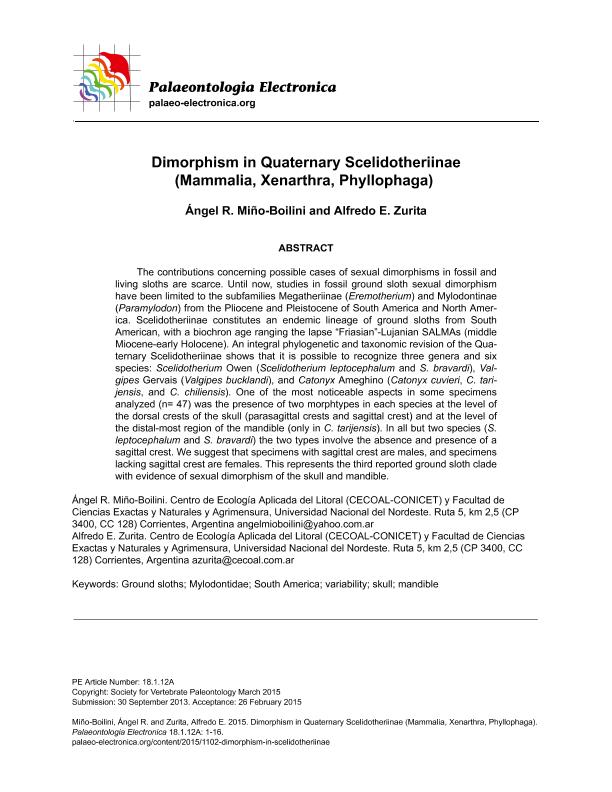Artículo
Dimorphism in quaternary scelidotheriinae (mammalia, xenarthra, phyllophaga)
Fecha de publicación:
03/2015
Editorial:
Coquina Press
Revista:
Palaeontologia Electronica
ISSN:
1094-8074
e-ISSN:
1532-3056
Idioma:
Inglés
Tipo de recurso:
Artículo publicado
Clasificación temática:
Resumen
The contributions concerning possible cases of sexual dimorphisms in fossil and
living sloths are scarce. Until now, studies in fossil ground sloth sexual dimorphism have been limited to the subfamilies Megatheriinae (Eremotherium) and Mylodontinae (Paramylodon) from the Pliocene and Pleistocene of South America and North America.Scelidotheriinae constitutes an endemic lineage of ground sloths from South American, with a biochron age ranging the lapse ?Friasian?-Lujanian SALMAs (middle Miocene-early Holocene). An integral phylogenetic and taxonomic revision of the Quaternary Scelidotheriinae shows that it is possible to recognize three genera and six species: Scelidotherium Owen (Scelidotherium leptocephalum and S. bravardi), Valgipes Gervais (Valgipes bucklandi), and Catonyx Ameghino (Catonyx cuvieri, C. tarijensis, and C. chiliensis). One of the most noticeable aspects in some specimens
analyzed (n= 47) was the presence of two morphtypes in each species at the level of
the dorsal crests of the skull (parasagittal crests and sagittal crest) and at the level of the distal-most region of the mandible (only in C. tarijensis). In all but two species (S. leptocephalum and S. bravardi) the two types involve the absence and presence of a sagittal crest. We suggest that specimens with sagittal crest are males, and specimens lacking sagittal crest are females. This represents the third reported ground sloth clade with evidence of sexual dimorphism of the skull and mandible.
Palabras clave:
Mylodontidae
,
South America
,
Variability
,
Skull
,
Mandible
Archivos asociados
Licencia
Identificadores
Colecciones
Articulos(CECOAL)
Articulos de CENTRO DE ECOLOGIA APLICADA DEL LITORAL (I)
Articulos de CENTRO DE ECOLOGIA APLICADA DEL LITORAL (I)
Citación
Miño Boilini, Ángel Ramón; Zurita, Alfredo Eduardo; Dimorphism in quaternary scelidotheriinae (mammalia, xenarthra, phyllophaga); Coquina Press; Palaeontologia Electronica; 18; 1.12A; 3-2015; 1-16
Compartir




